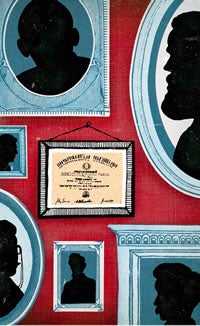As two HLS graduates are vying to lead the United States, we asked 6 legal historians on the faculty to reflect on the connections between legal education and leadership.
Looking Back to Move Forward
The American Revolution thrust lawyers to the forefront of public discourse
A distinguished historian at Yale—whose father had been an equally distinguished law professor at Harvard—once remarked that before the American Revolution, the leading public figures in America were ministers who thought about theology, while after the Revolution, they were statesmen who thought about politics. Most of them were lawyers. Lawyers furnished the intellectual justifications for independence before the war, wrote the Declaration of Independence during the war, led the diplomatic missions that cultivated allies and negotiated peace, made up 34 of the 55 delegates to the Constitutional Convention, and led the ratification efforts in every state. The Revolution thrust lawyers to the forefront of public discourse, and they remained there. For lawyers, the founding era is our golden age, and we cling to it (some—originalists, for example—more tightly than others), despite Randall Jarrell’s caution that the problem with golden ages is that the people who live in them complain that everything looks yellow.

In his brief time traveling in the United States just a few decades later, Alexis de Tocqueville observed that law permeated every part of American society. He did not think this a good thing, but it was the role of lawyers that most interested him. The tendency of almost every political question to resolve into a legal question gave lawyers outsized authority, which he feared their common-law training, with its emphasis on tradition and precedent, inclined them to wield conservatively, even anti-democratically. Nonetheless, remembering the Revolution, he ventured that democratic institutions could not be maintained without them.
Today, it is not just political questions, but social and economic questions as well, that resolve into legal questions. On a wealth of issues from the definition of marriage to financial regulation and beyond, lawyers are at the forefront, and because they are, they can influence more than just law. We still teach students to reason from precedent, but not to tie them to the past. At our very best, we train them to look backward so that they may learn to move forward. And when they do move forward, they can lead.
Bruce Mann’s books include “Republic of Debtors: Bankruptcy in the Age of American Independence” (Harvard, 2002).
A Social Process
Legal training is enormously helpful to anyone who has an interest in problem-solving, especially in the realms of politics or public policy. The legal profession also has comparative advantages over other high-status occupations that attract smart, ambitious people interested in public life.

Leadership in any profession is a social process: The opportunity for leadership depends, in part, on the historical moment and the cultural context. Many note the preponderance of lawyers in politics. One need think only of the relative dearth of women in politics decades after women began matriculating at law school in appreciable numbers to understand that correlation is not causation when it comes to law and leadership. Surely there are many women lawyers who would make fine political leaders, yet they never contemplate that path because there is little social expectation of female political leadership. In fact, there are barriers to it.
At the same time, public service by lawyers is a well-known and an honorable tradition. The law attracts many people who are concerned about social, political, and economic problems and who are capable of leadership. Why is that? One answer, I suspect, is that most areas of law are less technical and more accessible to able students than professions such as medicine or engineering. One cannot be admitted to medical school without having completed coursework in science. By contrast, one can be admitted to law school without any coursework in law or advocacy or any of the other touchstones of the legal profession. The same flexibility pertains to career options available to law graduates. Many students consciously pursue careers in law in hopes of acquiring analytical skills that can be applied to a wide variety of problems and used in many fields.
The lawyer’s training makes the pursuit of careers in nonlegal realms feasible, but an individual’s talents, personality traits, personal commitments and social networks, among other factors, influence whether an attorney can achieve success outside of law or in areas of the law that require political leadership. Think of Louis Brandeis LL.B. 1877 or Thurgood Marshall. They shared a sense of mission to ameliorate inequality; family and community nurtured those commitments long before these men studied law. Brandeis spoke of the “opportunity in law”; he encouraged attorneys to be statesmen, using their social status and legal training to tackle socioeconomic problems. Marshall seized the opportunity in law and applied it to the problem of racial inequality. The willingness of Brandeis and Marshall to employ new approaches to advocacy powered their success. Such creativity and conviction are present in leaders, but not necessarily in lawyers.
The success of these leaders also derived in part from interpersonal intelligence. Marshall loved to engage audiences through storytelling about the black experience, including his own. His interpersonal acumen bore no necessary relationship to his legal training, but it influenced his success as a leader and as a lawyer. These personal traits helped Marshall as he sought critical allies in community groups, in civic organizations and in politics. Brandeis not only built alliances with elected officials but also developed connections with labor leaders and women-led civic groups. His ability to form relationships with people from different walks of life facilitated his political and legal objectives.

Over time, through the example of lawyers such as Brandeis and Marshall, the law has acquired a reputation as a profession well-suited to talented individuals who wish to make a social impact. It oversimplifies the lives and work of these men to view legal training as the most likely explanation for their success. Leadership in any realm is more complicated: Structure, personality, social networks, comparative advantages, the zeitgeist and chance all shape a life.
Tomiko Brown-Nagin is the author of “Courage to Dissent: Atlanta and the Long History of the Civil Rights Movement” (Oxford, 2011). She is now at work on a book about civil rights lawyer Constance Baker Motley.
Part of a Long Conversation
By accident and by design, Harvard Law has had a profound effect on the world beyond the traditional confines of law practice

The history of Harvard Law School has seen a long conversation about the relationship between law school training and public life, and both President Obama ’91 and Gov. Romney J.D./M.B.A. ’75 are part of that conversation. In the early 19th century, Joseph Story helped create a national law school that consciously launched its students into careers in law, business, letters, arts and government. In that era, most lawyers trained for the bar through apprenticeship, and the law school could carve out a distinctive mission for itself in helping to define university-based American legal education. Later, the pendulum swung back as the modern Harvard Law School was founded on the premise that legal training was distinct from other pursuits. In the early 20th century, figures such as Roscoe Pound and Felix Frankfurter LL.B. 1906 pushed many students—among them, future NAACP lawyer Charles Hamilton Houston LL.B. ’22 S.J.D. ’23—to search out the connections between legal rules and the larger social, economic and political world. That push helped reform American society—shaping both the New Deal and the civil rights movement.

By the time Romney arrived in the 1970s, the school was once again emphasizing the autonomy of law, and Romney, according to my colleague Detlev Vagts ’51, did not immerse himself deeply in that core project. Romney apparently found the business school more to his liking than law. Obama, most likely, would have also found the law school of the 1970s to be an off-putting place. However, he was lucky enough to arrive in the late 1980s, when courses with names like “Law and Society” and “Reinventing Democracy” were being offered, reflecting yet another transformation of the school that continues to this day. Both by accident and by design, the law school has had a profound effect on the world beyond the traditional confines of law practice, and the 2012 presidential race is one important episode in a much larger journey.
Kenneth Mack is the author of “Representing the Race: The Creation of the Civil Rights Lawyer” (Harvard, 2012) and co-editor of “The New Black: What Has Changed—and What Has Not—with Race in America” (The New Press, forthcoming in 2013).
Law School and the Chief Executive
Of the 24 U.S. presidents who served before 1900, 18 were lawyers, but only two attended law school

Does legal training prepare one for the presidency? The question is quite difficult to answer, given the very different training most lawyers received in the 19th century. The vast majority of 19th-century lawyers studied for admission to the bar on their own, or under the guidance of a mentor, or as an apprentice to a practicing lawyer. Of the 24 chief executives who served before 1900, 18 (75 percent) were lawyers, but only two, Rutherford B. Hayes (Harvard Law School) and William McKinley (Albany Law School), attended law school instead of apprenticing. Until President Barack Obama ’91, President Hayes LL.B. 1845 was the only chief executive to have attended HLS.
Since 1900, there has been a dramatic decline in the number of lawyers who ascended to the presidency. Of the 19 presidents who have served since the turn of the century, only eight (about 42 percent) have been lawyers. All but Calvin Coolidge, who apprenticed, attended law school. Except for President (and future Chief Justice) Taft, who returned home to study at Cincinnati Law School, the remaining lawyer presidents attended national law schools: FDR (Columbia), Nixon (Duke), Ford (Yale), Clinton (Yale) and Obama (Harvard).

Can we compare the lawyer presidents to the nonlawyers who became chief executives? If we consult one ranking of presidents prepared from polling academic historians and political scientists, we learn that three of those ranked in the top 10 (Lincoln, FDR and Jefferson) were lawyers while five of those ranked in the bottom 10 (Buchanan, Pierce, Fillmore, Tyler and Nixon) were lawyers. All but Nixon became lawyers through apprenticeship.
Morton Horwitz’s books include “The Warren Court and the Pursuit of Justice” (Hill & Wang, 1998) and “The Transformation of American Law, 1870-1960: The Crisis of Legal Orthodoxy” (Oxford, 1992).
Leading by Design
History is bursting with examples of design leadership—from 12th-century treatise writers to the framers of the Constitution
Institutional design, legal architecture, the procedures and processes of social justice—all are structures that matter enormously. People who think about how to build and operate those structures have great influence in shaping our common space. They are not always lawyers. John Locke, for example, was trained as a medical doctor. But Locke read much constitutional theory—we might even claim him as a self-taught lawyer—and he worked closely with lawyers and legislators. Law training teaches people to think about institutions and processes; it can empower them to lead “by design,” as it were, design of a future world.

History is bursting with examples of different periods and types. The constitution John Locke drafted for South Carolina never took effect, but it advanced ideas about religious liberty to a greater degree and about suffrage on the basis of lower property requirements than were then common. In England, Locke worked with lawyers like Lord Keeper Somers and members of Parliament to define both trade and monetary policy. Their intervention arguably produced the international regime that became the gold standard.
For a far earlier example of design “leadership” by unsung lawyers, we might look to the treatise writers and common-law judges. The writ of debt that they defined during the 12th and 13th centuries sent English commercial practice in a different direction from the commercial practice of the Continent. The terms of common-law debt established “nominalism” in early English exchange, a practice of holding valuations constant according to the unit of account used to quote prices. That constancy in turn influenced economic development and the way that English elites and working people bargained over its shape.

The final example is the most familiar to us today: Many of those framing the Constitution were lawyers. John Adams, James Otis, James Madison and Thomas Jefferson conceived themselves to be actively constructing a republic. The blueprint they produced changed the course of American history. It contained brilliant insights, like the importance of popular sovereignty. It embedded tragic denials of justice, including the enslavement of millions of Americans. In that sense, it demonstrates the power and responsibility that can come with leading by design.
Christine Desan’s many articles include “Coin Reconsidered: The Political Alchemy of Commodity Money,” 11 Theoretical Inquiries in Law 13 (2010) and “From Blood to Profit: The Transformation of Value in the American Constitutional Tradition,” 20 Journal of Policy History 26 (2008).
Lawyers and the Leadership Class
The study of law has always attracted those who desire to exercise leadership
It does not surprise that two individuals who went to law school would vie for the presidency. Twenty-six presidents were trained as lawyers, and there were other lawyer candidates who did not make the cut. What is unusual is having two candidates who went to the same law school. While others have voiced concerns about this, I have none at all.

The study of law has always attracted individuals who desire to exercise leadership and influence at all levels of society. That makes sense. Large or small, communities and nations are knit together by laws and rules. Whoever understands the workings of the laws—and how to use them—can make a strong case for his or her right to be in the forefront of the leadership class. The well-known ambivalence that many have about lawyers as practitioners does not prevent people from looking to lawyers to lead in a wide variety of venues outside of the courtroom. Lawyers are seen as problem-solvers. Law school is supposed to teach you approaches to problem-solving, and if one practices—well, you get practice doing that. Learning how to manage the expectations of people is also a big part of a lawyer’s job. That’s an effective tool if one wants to rise through any ranks.
Annette Gordon-Reed’s books include “Thomas Jefferson and Sally Hemings: An American Controversy” (Virginia, 1997) and “The Hemingses of Monticello: An American Family” (Norton, 2008).
